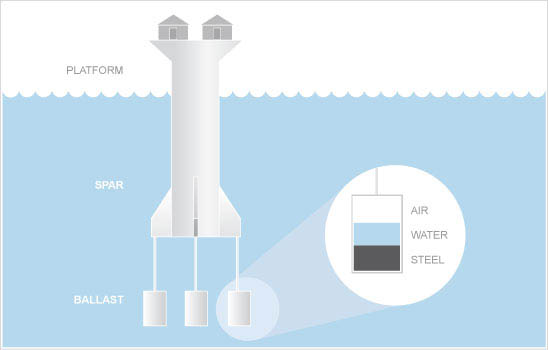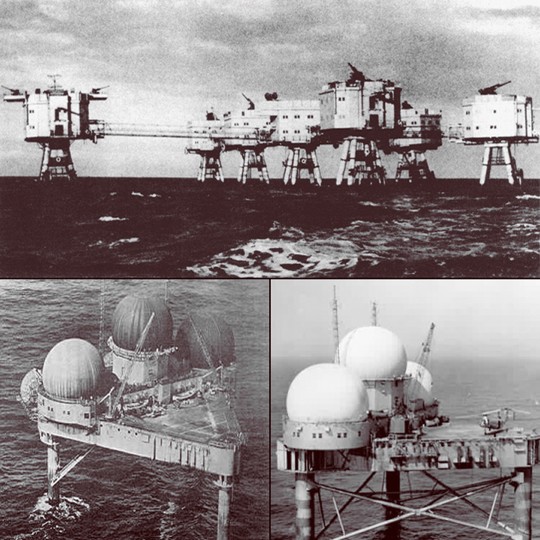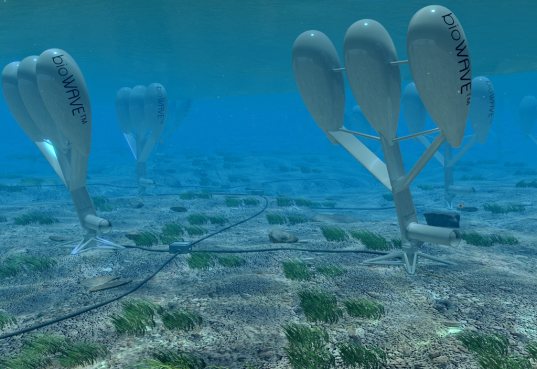 [Image: Illustration by Holl Liou, courtesy of Wired].
[Image: Illustration by Holl Liou, courtesy of Wired].
Wired reports on “a small team of Silicon Valley millionaires” who hope to develop “a new option for global citizenship: A permanent, quasi-sovereign nation floating in international waters.”
They call this practice seasteading.
The seasteaders want to build their first prototype for a few million dollars, by scaling down and modifying an existing off-shore oil rig design known as a “spar platform.” In essence, the seastead would consist of a reinforced concrete tube with external ballasts at the bottom that could be filled with air or water to raise or lower the living platform on top. The spar design helps offshore platforms better withstand the onslaught of powerful ocean waves by minimizing the amount of structure that is exposed to their energy.
Build enough of these spar platforms and you’ve got yourself a “deep-water city-state.”
The group’s 300-page book on the managerial practicalities of running “modular seastead groups” references everything from Sealand, the offshore micronation, to the Texas Tower, to houseboats, to the dangers of tropical storms.
 [Images: The Maunsell Towers (top), unmentioned by the libertarian seasteaders, and the Texas Tower (bottom)].
[Images: The Maunsell Towers (top), unmentioned by the libertarian seasteaders, and the Texas Tower (bottom)].
They touch on the political and economic circumstances involved in steading the high seas, including SOLAS, the International Convention for the Safety of Life at Sea, and UNLOS, the United Nations Law of the Sea. They mention the process of buying a Flag of Convenience, in which hopeful microsovereigns can “shop around for a country that has the least objectionable laws and rates, and count on the seller’s apathy to minimize restrictions. A seastead is potentially high-profile, and if it proves a serious embarrassment to a registrar it may lose its flag.”
The seastead’s power storage needs are then discussed in terms of electrochemical batteries, gravity batteries, and supercapacitors, and the production of this power will, the authors presume, come from wind and solar systems, and even one or two fuel-powered generators. Of course, there’s also the power of the sea to consider – and the authors’ “favorite” method for harvesting “wave power” is something called Isaac’s Wave Pump.
 [Image: Tapping into oceanic motion with BioPower Systems].
[Image: Tapping into oceanic motion with BioPower Systems].
In any case, one can fantasize forever about endless small changes in the construction of a functioning seastead. (Note to Chronicle Books: publish an architectural guide to seasteading; it’ll be a huge hit on Father’s Day).
What interests me here, aside from the architectural challenge of erecting a durable, ocean-going metropolis, is the fact that this act of construction – this act of building something – has constitutional implications. That is, architecture here proactively expands the political bounds of recognized sovereignty; architecture becomes declarative.
The stakes for design have gone up, in other words. It’s not just a question of producing better loft apartments, for which you can charge an extra $300,000, or of perfecting the art of luxury kitchen space; it’s a question of designing architecture for extreme conditions and, should your architecture survive, thus opening up room for a new form of what might be called post-terrestrial sovereignty, i.e. governance freed from landed terrain.
Which is not to be confused with advocacy of the project; I just like discussing its political side-effects: architecture becomes wed with, indeed inseparable from, a political project. It is construction in the service of constitutionality (and vice versa).
Wed with oceanic mobility, the architecture of seasteading doesn’t just aesthetically augment a natural landscape; it actually encases, or gives physical shape to, a political community. It is architecture as political space in the most literal sense.
Partially as a result of your Flickrstream, I was working on this (http://www.hawkdog.net/wordpress/archives/347) as you were posting Deep-water City-states. Thanks for the stimulus!
Hey, Geoff!. I’m a fan of BLDGBLOG and a fellow blogger from Argentina and I was wondering if you would have the time and disposition to conduct a brief interview for my blog (www.elbailemoderno.blogspot.com). I hope it doesn’t bother you that I’m asking this in the comments section, but I read your profile and it seems the most direct way to get an answer from you. If you’re interested contact me at snark84 at gmail.com. Anyway, I’ll be keeping an eye on the comments section if you want to answer here.
Thanks a lot and keep up the excellent work!.
Amadeo Gandolfo.
Hey, Amadeo, I just emailed you.
And thanks for the link, Dr. Hypercube. Nice post.
Re: Architecture as sovereignty, construction as constitutionality
Yes! You’ve got it exactly. We honestly don’t know if the economics/engineering will work out (we’ll know a lot more by the end of the year). But the key to this idea is that we’re transforming a political problem into an engineering one. Just by solving an engineering problem (which humans are damn good at!), we can transform politics (and in a direction which moves power towards the individual).
That’s why this is big and exciting. Glad to see you get it. Perhaps eventually we can convince you to advocate it too :).
Hey Geoff, I am interested in setting up a blog about Architecture, but am really amazed about how you seem to have so much inspiration! Where do you get it all from? Im a student of architecture in England, and cant wait to get my own blog set up.
Don’t want to put a dampener on your idea but surely such structures would come under the jurisdiction of international maratime law. In which case they would not gain independance unless anyone and i mean any passing traffic or wandering international jurisdiction passed by. They would be subject to pirates and all sorts of horrible problems that beset the non aligned. Independence has never seemed to foster utopia, hence humans have come up with government.
I came across this French architect at an exhibition ( Airs de Paris) at the Centre Pompidou last year.
http://www.rougerie.com
On the political side of it, consider also the (ahem) pioneering role of the Principality of Sealand (here and here).
I would have to concur with Mr. Anonymous there, as depressing as it all may be in the end. I would recommend that the Seasteaders spend a little bit of time retracing the experience of many of the various Socialist Utopians who ventured out near the turn of the last century with similar political/architectural aspirations. As admirable as an endeavor as it may seem, these Seasteaders are bound to have their dreams crushed by a whole host of opportunists and/or imperialists.
Wow…what next? Living in Mars maybe…amazing! Geoff, I don’t know where you get your inspirations from but they’re all amazing and defy imagination. There’s also a documentary I saw in History Channel that featured a ship where one can choose to live (not sure who the company was). This Deep-Water City-States must be an off shoot, although the architects have taken it at a “deeper” level.
There was an interesting and quite critical article about the politics of seasteading by Science Fiction writer China Mieville a while ago:
Floating Utopias
You might want to consider this project when landing on an identity for your seaside abode. The Meta Haven: Sealand Identity Project from Jan van Eyck Academie.
http://www.radiodays.org/metahaven/metahaven.html
Anonymous has it correct – if you have a Flag of Convenience, the vessel falls under the law of that nation. Regardless of that, international law regards you as a citizen of the nation that issues your passport. (Nor can you dodge the latter by simply issuing your own.)
These structures are neither sovereign nor independent in any useful sense of the word. They are nothing but LARP gaming on a grand scale.
Do the political problems make the city impractical, or do they just require the politicians to be as creative as the engineers?
I think these places filled with Libertarian millionaires would constitute a unique hell. It really sounds like a good premise for a J.G Ballard novel, with the inhabitants abandoned by their servants and mantainance staff slowly degenerating into savagery. Meanwhile down below rust and waves slowly gnaw away at the foundations…
Even if these guys managed to coax sovereignty out of these floating windmills I fail to see how the stakes have been raised. What we have is another ghetto at sea accesible at massive expense. If anything the stakes have been erased – let’s jump ship and start from scratch, like the only believable discourse is wholesale redemption in verdures of ever diminishing virginity, for all the talk of new nation states then it is in this way completely American.
Geoff
love this seasteading idea, too. could be useful for either glob warming or glo cooling. either way.
Wonder if one day you can blog about the pros and cons of polar cities? Tried to reach you but hard to get through. see images and blog info, inclduing NYTimes blog post, here
http://pcillu101.blogspot.com
Images were created by artist Deng Cheng-hong in Taiwan, my next door neighbor.
email me at danbloom GMAIL
thanks
Hey Dan – Thanks for the link.
THE NEWS RE. FORMER FORT ROUGH TOWERS SEALAND AND WINDFARM PROJECT LONDON ARRAY UNDER THE LINK:
Report 1> http://www.king-marduk.de/viewtopic.php?t=109
Report 2> http://www.king-marduk.de/viewtopic.php?t=108